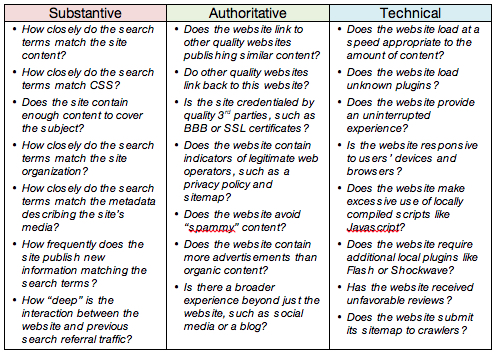7 Pragmatic Search Engine Optimization Principles All Beginning Marketers Must Know
Andrew Bloom | Associate Account Manager | Designing North Studios
There are a lot of different ways users can arrive at your web properties. Each way is called a channel – and often times each channel presents its own set of challenges for marketers.
First you have referral traffic. This is the backbone of the world-wide-web. Sites linking to different sites with similar content and user groups.
Then you have social traffic, which is like referral traffic for the 21st century. But because social media traffic is so often contained on mobile devices, it’s actually using a completely different architecture from what we think of as the world-wide-web.
And let’s not forget those people whom actually type your site into the address bar of their browsers and navigate to your site directly. This is called direct traffic.
Most other traffic arrives via a search engine like Google or Bing/Yahoo. These search engines do us the immense favor of indexing the unfathomably massive information hairball that is the world-wide-web and guiding us to what – in their opinion – we think we want. But these search engines don’t work for free! They make back their investment by publishing advertisements, which usually cut to the front of the line of search results so we can see the ads first. This traffic is called sponsored search traffic.
The rest of the traffic referred by search engines is called organic search traffic, and improving your website’s visibility in these rankings is the focus of this article.
For novices, making sense of all the strategies and jargon associated with SEO can be overwhelming. And that’s understandable – online marketing is still in its adolescence, and access to trustworthy information is still limited.
I’m here to help. These 7 tips can help any junior marketer make the most of their SEO.
1. Understand the monetary value of effective search rankings.
Let’s start real basic: why do SEO at all? If it’s simply about introducing your message to all the relevant eyeballs out there looking for content like what your site provides, why not just pay the search engines to feature your website?
I’d answer this question by asking you to do a Google search on – well – just about anything. You’re going to see two sponsored ad listings at the top of the results, then a list of 20 organic search results in the main table, and six more sponsored ad listings down the side.
Advertisers are spending thousands, even hundreds of thousands, of dollars every day to serve these ads. What then is the value of optimizing your website to appear in the top organic placement? If the advertiser in sponsored rank two is paying $5000 a day and the advertiser in rank 3 is paying $3000 a day, then your website’s value in the top organic slot is in the territory of around $4000 a day. Without having to pay Google a dime.
Imagine all those advertisers fretting over their ROI at the end of the day. Did their sponsored-channel income justify the budget they spent on cutting the line with ads? Not always.
Let me tell you a secret: web marketers who have mastered SEO strike terror into the hearts of programmatic advertising agencies. Because you have done for free what they’ve spent thousands of dollars of someone else’s money to achieve. Your organic listing next to their sponsored listing mocks them like an arrogant howler monkey.
That’s the bottom dollar value of SEO.
2. Be congruent.
Ok, so how is SEO done in practice? In its simplest form, SEO involves establishing congruency between a search engine user’s expectations and the experience your website delivers. This is a far cry from how search engines operated in the Web 1.0 era of the Internet, where population search history and the ubiquitous “hit counter” determined rankings. Nowadays, even the most humble website may outrank more popular websites if the search engine perceives it to provide visitors an experience more congruent with the terms they entered into the search field.
Congruency should strike you as a hopelessly abstract, even academic term right now. That’s OK – I’m going to explain what it is soon. Right now, it’s more important to understand what it’s not.
Congruency is not what’s popular or all encompassing. If you serve all 50 US states in the same way, you can’t post the identical content on one page targeting every state. You can’t hide the names of Marvel superheroes in invisible text all over your footer.
Congruency is not just the words in the search terms. Search engines understand language. If your site is about college students, you will do fine with searches on university students.
Congruency is not semantic. Close synonyms are OK. But human language and intention are still very complex beasts. A user may be searching for “coffee health alternatives” and receive a page about the hipster coffee shops in their area. We are at least 10 years away from Web 3.0 semantic search. Until then, you need to make sure your website is focused on what is literally relevant in search terms.
This is why so many wise online marketers these days have come to conclude SEO is nothing more than good content marketing; it’s easier to just play Google’s game and get your site to the top by providing the undeniably best content out there for your niche.
3. You have to crawl before you can walk. Literally.
While the exact parameters of search engine ranking algorithms are among the most carefully guarded secrets in the corporate world, all of the popular search engines rely on a page crawler to gather data on the website’s side of the equation.
A common misconception is that the page crawler evaluates a website at the time of a user’s search. This is more intuitive, but ultimately too computationally intensive. Instead, it’s actually far more efficient for companies like Google to constantly scan the entire Internet* top to bottom! Search terms are then evaluated against Google’s internal caches of the world-wide-web to determine ranking. It’s also important to note that these Internet-wide page-crawls can sometimes take months to complete, and so there is often a delayed fuse for marketers to notice the results of their positive SEO efforts.
In practice, improving your site’s SEO means adding all the congruencies you can to make it as easy as possible for these page crawlers to access and understand your website.
4. Work all the angles.
Page-crawlers are computer programs, and therefore look at a website differently from how a human does. A page-crawler cannot appreciate how nicely your typefaces compliment each other, or how awesome it would be to drive that motorcycle in the picture.
To this end, effective SEO always involves some degree of relinquishing complete creative control over how your website appears. It’s a tragic sacrifice, but ultimately one that’s worth making. The page-crawlers are generous overlords, and reward our toils with better rankings – and more traffic.
It’s easiest to think about page-crawlers as a series of questions being asked of your website. The better your website answers these questions, the better the report back to the search engine’s cache.
These questions usually fall into three categories:

It’s also a generally good idea to prioritize substantive SEO over authoritative SEO and authoritative SEO over technical SEO. A website with decently formatted, somewhat relevant content will outrank a similar website with superb content and no links elsewhere. A website with no social media extensions will outperform a similar website with great social media extensions that loads slower than dial-up.
5. Resist the temptation of SEO doodads.
SEO is possibly the most misunderstood and misconstrued field of online marketing, and consequently there are a million and one tools available cheaply or for free that purport to offer the website manager a leg-up in search rankings.
My advice to you is to ignore these, and instead focus on only one or two powerful toolkits for site diagnosis. My favorite at present is Screaming Frog SEO Spider, a downloadable program which makes it easy for you to analyze, audit, and review a site from an onsite SEO perspective. It’s particularly useful for analyzing older sites, sites on a custom CMS, and medium to large sites where manually checking every page would be prohibitively labor-intensive.
It also highlights critical areas where you may have fatal errors or simply missing content:
• Page status codes. Are any of your pages missing or outbound links broken? 404 errors are toxic to search rankings.
• Page titles. Are your page titles using a consistent schema and giving crawlers an idea of your site organization?
• Meta descriptions & keywords. Are all of your pages providing search engines with a metadata explanation of what the page is about?
• Headlines and Subheadlines. Page crawlers place a lot of weight on content marked in H1 and H2 tags to determine what your page is about. Do you have the right content? Do you have the right amount of content?
• Page depth. Is your website organization congruent with what visitors might expect? If you’re selling a product or service, crawlers expect informational pages to be closer to the surface and billing, checkout, and FAQ pages closer to the exit path.
• URI name schemes. Are your page URI’s descriptively named after what’s on the page? For example, www.yourwebsite.com/your_product is going to perform a lot better than www.yourwebsite.com/index/products/p?=aX3n4v7uP.axsp
You can also use SEO Spider to generate a sitemap file to reupload to your site’s root directory after making any significant changes.
6. Get it done right the first time.
You’re not on your own out there. You’re not the first to want to make the SEO process less arduous. Here’s the silver lining: smarter, better people than ourselves have already done all the hardest work to make this happen.
I feel bad for the far too many new marketers out there who turn to their bespectacled nephew or a local Computer Science undergrad to code a new website from scratch for them. And when the website’s done, it’s still not optimized for SEO.
In the age of WordPress, Squarespace, Wix, Shopify, GoDaddy, and Google Sites, there is virtually no reason for a small to medium-sized unspecialized website to be created from scratch. And the great thing about these CMS platforms is that virtually all of the SEO is taken care of already – behind the scenes, built into the core architecture of the website.
With a WordPress or Squarespace site especially, all the relevant SEO fields are readily available for editing, smoothly integrating into the same workflow process used for writing and designing your site content.
There are also a number of WordPress plug-ins available to help with specialized SEO applications, but please keep in mind Tip #5.
7. Don’t rule out success strategies for other channels.
As with any strategy to drive traffic to your website, it’s important to be conscious of the efficiency and pragmatism of your efforts. SEO may be relatively cheap to implement, but it can often become time consuming. I’ve occasionally seen considerable labor hours expended on SEO efforts to reach search engine placements that are far less valuable than the comparable wages.
That’s why it’s so critical to assess the value of your desired placements upfront. If you can’t spare the time and labor, it’s far more economical to you and your website to pursue sponsored search traffic and simply purchase clicks to your website.
This mode of programmatic advertising is often called Pay-Per-Click or PPC, and it carries its own set of challenges and best practices. However, marketers who are generally good at PPC tend to also see their organic search rankings improve and vice versa. Many of the action steps taken to improve SEO also benefit quality scores – which Google and Bing/Yahoo temper against auction-like bids to determine where your ad ranks.
Whichever route you choose, be sure to organize your tasks like any project. It’s far easier to pivot between strategies at convenient project phases than it is in the middle of a nebulous storm of half-written meta descriptions and one-way page links.





